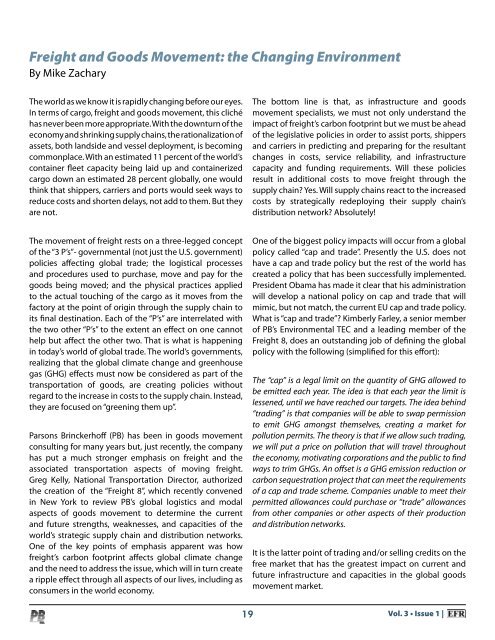Volume 3 Issue 1.indd - Parsons Brinckerhoff
Volume 3 Issue 1.indd - Parsons Brinckerhoff
Volume 3 Issue 1.indd - Parsons Brinckerhoff
Create successful ePaper yourself
Turn your PDF publications into a flip-book with our unique Google optimized e-Paper software.
Freight and Goods Movement: the Changing Environment<br />
By Mike Zachary<br />
The world as we know it is rapidly changing before our eyes.<br />
In terms of cargo, freight and goods movement, this cliché<br />
has never been more appropriate. With the downturn of the<br />
economy and shrinking supply chains, the rationalization of<br />
assets, both landside and vessel deployment, is becoming<br />
commonplace. With an estimated 11 percent of the world’s<br />
container fleet capacity being laid up and containerized<br />
cargo down an estimated 28 percent globally, one would<br />
think that shippers, carriers and ports would seek ways to<br />
reduce costs and shorten delays, not add to them. But they<br />
are not.<br />
The bottom line is that, as infrastructure and goods<br />
movement specialists, we must not only understand the<br />
impact of freight’s carbon footprint but we must be ahead<br />
of the legislative policies in order to assist ports, shippers<br />
and carriers in predicting and preparing for the resultant<br />
changes in costs, service reliability, and infrastructure<br />
capacity and funding requirements. Will these policies<br />
result in additional costs to move freight through the<br />
supply chain? Yes. Will supply chains react to the increased<br />
costs by strategically redeploying their supply chain’s<br />
distribution network? Absolutely!<br />
The movement of freight rests on a three-legged concept<br />
of the “3 P’s”- governmental (not just the U.S. government)<br />
policies affecting global trade; the logistical processes<br />
and procedures used to purchase, move and pay for the<br />
goods being moved; and the physical practices applied<br />
to the actual touching of the cargo as it moves from the<br />
factory at the point of origin through the supply chain to<br />
its final destination. Each of the “P’s” are interrelated with<br />
the two other “P’s” to the extent an effect on one cannot<br />
help but affect the other two. That is what is happening<br />
in today’s world of global trade. The world’s governments,<br />
realizing that the global climate change and greenhouse<br />
gas (GHG) effects must now be considered as part of the<br />
transportation of goods, are creating policies without<br />
regard to the increase in costs to the supply chain. Instead,<br />
they are focused on “greening them up”.<br />
<strong>Parsons</strong> <strong>Brinckerhoff</strong> (PB) has been in goods movement<br />
consulting for many years but, just recently, the company<br />
has put a much stronger emphasis on freight and the<br />
associated transportation aspects of moving freight.<br />
Greg Kelly, National Transportation Director, authorized<br />
the creation of the “Freight 8”, which recently convened<br />
in New York to review PB’s global logistics and modal<br />
aspects of goods movement to determine the current<br />
and future strengths, weaknesses, and capacities of the<br />
world’s strategic supply chain and distribution networks.<br />
One of the key points of emphasis apparent was how<br />
freight’s carbon footprint affects global climate change<br />
and the need to address the issue, which will in turn create<br />
a ripple effect through all aspects of our lives, including as<br />
consumers in the world economy.<br />
One of the biggest policy impacts will occur from a global<br />
policy called “cap and trade”. Presently the U.S. does not<br />
have a cap and trade policy but the rest of the world has<br />
created a policy that has been successfully implemented.<br />
President Obama has made it clear that his administration<br />
will develop a national policy on cap and trade that will<br />
mimic, but not match, the current EU cap and trade policy.<br />
What is “cap and trade”? Kimberly Farley, a senior member<br />
of PB’s Environmental TEC and a leading member of the<br />
Freight 8, does an outstanding job of defining the global<br />
policy with the following (simplified for this effort):<br />
The “cap” is a legal limit on the quantity of GHG allowed to<br />
be emitted each year. The idea is that each year the limit is<br />
lessened, until we have reached our targets. The idea behind<br />
“trading” is that companies will be able to swap permission<br />
to emit GHG amongst themselves, creating a market for<br />
pollution permits. The theory is that if we allow such trading,<br />
we will put a price on pollution that will travel throughout<br />
the economy, motivating corporations and the public to find<br />
ways to trim GHGs. An offset is a GHG emission reduction or<br />
carbon sequestration project that can meet the requirements<br />
of a cap and trade scheme. Companies unable to meet their<br />
permitted allowances could purchase or “trade” allowances<br />
from other companies or other aspects of their production<br />
and distribution networks.<br />
It is the latter point of trading and/or selling credits on the<br />
free market that has the greatest impact on current and<br />
future infrastructure and capacities in the global goods<br />
movement market.<br />
19 Vol. 3 • <strong>Issue</strong> 1 |

















